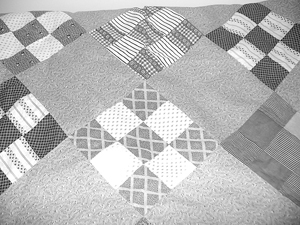AROUND THE FRAME

Happy New Year to all and may your quilting time bring you peace and relaxation.
Your quilt is in need of fabric replacement. Some vintage fabrics disintegrate for a reason and should not be used. Do you remember the Tupperware canister sets from the 1970s with the ridged seals in harvest gold, green, and brown? Sometimes if you took your palm and pushed in the middle of the brown seal it would crack and break apart. What the Tupperware folks learned was there was something in the brown dye chemically affecting the plastic and weakening it. They resolved the problem by changing the dye.
The same type of situation played out in the mid-late 1800s when the root of the madder plant was used to produce an entire range of colors from a reddish orange to purple to shades of browns from copper to almost black. A mordant (French for “biting”) refers to a substance added in the dyeing process to make the dye adhere to the cloth and make the colors more vivid. Metallic salts such as copper, iron, tin and alum were commonly used solely or in combination in the mordanting process.
Unfortunately the iron salts causes fabric damage. The darker the brown, the better the chance the fabric will crack, split, crock or just plain rot! If used as replacement fabric in a quilt, you run the risk of revisiting the quilt in the future with the same type of damage. Fortunately madder brown fabrics are reproduced today in a variety of shades and designs to blend into vintage quilt restoration projects.
Another vintage fabric to approach with caution is chrome yellow and orange. Look for old fabric the color of cheddar cheese. Made with chrome, it tends to crock (rub-off). I have a beautiful quilt with chrome orange not only on the top, but now on the backside probably due to how it was folded. When not on display, the quilt is kept in an acid free box wrapped in acid free paper to avoid future disasters.
Next issue: Why does the silk fabric in my crazy quilt fall apart when the rest of the fabric is just fine?
If you have a quilting/restoration question, contact me at bornagainquilts@verizon.net or visit the Web site at www.bornagainquilts.com.
- Sewing For A Higher Purpose ~ Around The Frame - April 12, 2024
- National Quilting Day 2024 ~ Around The Frame - March 1, 2024
- Reunited! ~ Around The Frame - February 2, 2024


